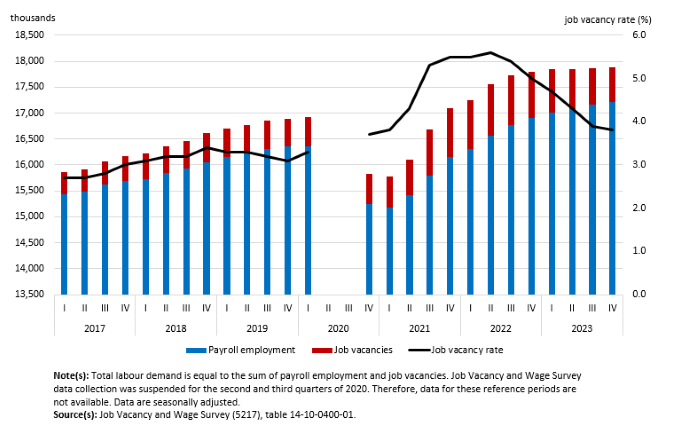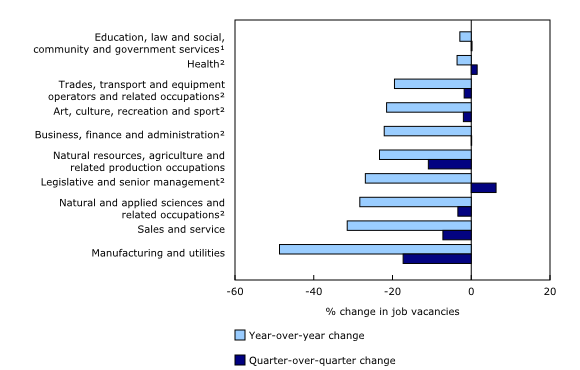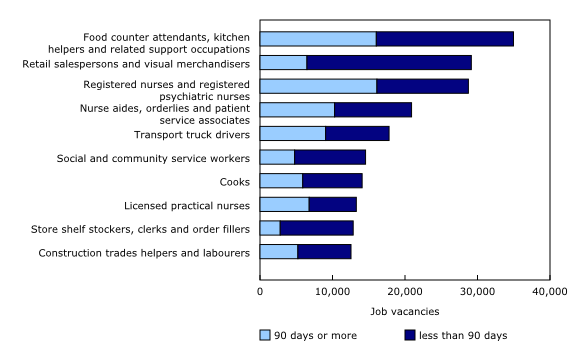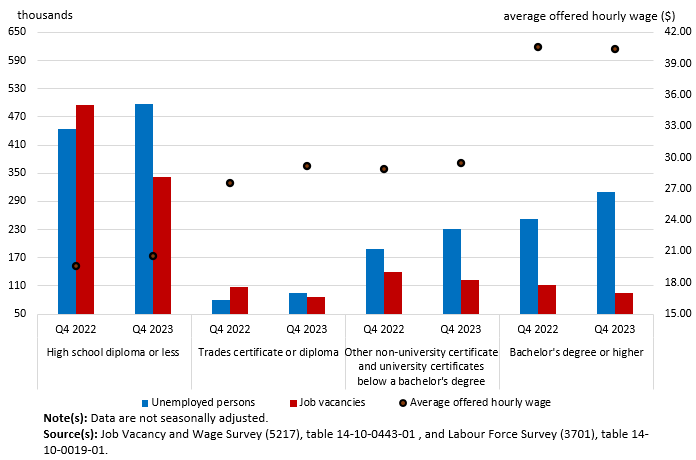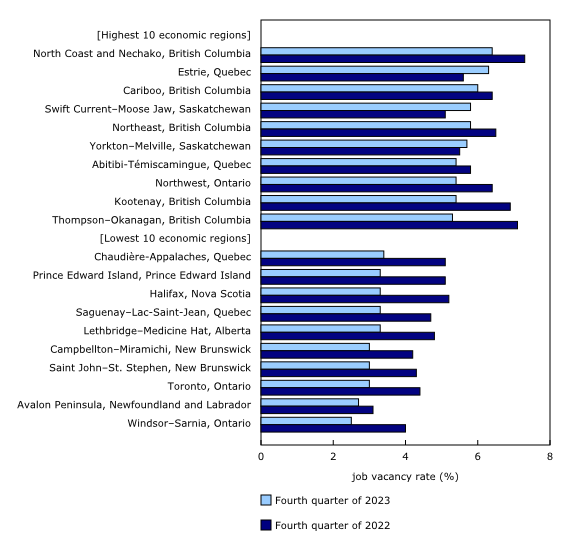Job vacancies, fourth quarter 2023
Released: 2024-03-19
Job vacancies decline at a slower pace in the fourth quarter
Job vacancies fell by 25,400 (-3.6%) to 678,500 in the fourth quarter of 2023, marking the sixth straight quarterly decline from the record high reached in the second quarter of 2022 (983,600).
Meanwhile, payroll employment rose by 37,700 (+0.2%) in the fourth quarter of 2023. Total labour demand (the sum of filled and vacant positions) in the fourth quarter was virtually unchanged from the third quarter and was up 0.5% from the fourth quarter of 2022.
The job vacancy rate—which corresponds to the number of vacant positions as a proportion of total labour demand—decreased 0.1 percentage points to 3.8% in the fourth quarter of 2023, marking the sixth consecutive quarterly decline. The job vacancy rate in the fourth quarter was at its lowest since the first quarter of 2021.
There were 1.8 unemployed persons for every job vacancy in the fourth quarter of 2023, up from 1.7 in the previous quarter, and 1.2 in the fourth quarter of 2022.
Three broad occupation groups drive decline in job vacancies
Job vacancies decreased in 3 of the 10 broad occupation groups in the fourth quarter of 2023: sales and service occupations (-16,000 to 206,000), manufacturing and utilities (-4,700 to 22,600), and natural resources, agriculture and related production occupations (-1,800 to 14,800). Job vacancies were little changed in the remaining broad occupation groups.
Widespread year-over-year decreases in vacancies across broad occupation groups
On a year-over-year basis, job vacancies fell in 9 of the 10 broad occupation groups in the fourth quarter. The largest year-over-year decline was seen in sales and service occupations (-93,800; -31.5%), which accounted for nearly half (46.4%) of the total net year-over-year decrease (-204,400; -23.1%) in vacancies.
There were fewer vacancies in eight other broad occupational groups in the fourth quarter, including trades, transport and equipment operators and related occupations (-33,400; -19.5%), business, finance and administration (-22,900; -22.1%), and manufacturing and utilities (-21,400; -48.7%).
Vacancies in the fourth quarter were virtually unchanged in occupations in education, law and social, community and government services compared with a year earlier.
Sales and service occupations continue to drive decline in overall vacancies
The year-over-year drop in sales and service occupations in the fourth quarter was driven by declines in vacancies for food counter attendants, kitchen helpers and related support occupations (-23,200 to 35,000), retail salespersons and visual merchandisers (-19,400 to 29,100), and cooks (-6,100 to 14,100) (not seasonally adjusted).
Year-over-year decreases in vacancies in health occupations
In the fourth quarter, job vacancies in health occupations held steady from the previous quarter, but were down by 3,400 (-3.6%) to 91,900 on a year-over-year basis. The third quarter of 2023 had marked the first year-over-year decline in job vacancies for health occupations since the first quarter of 2015, when comparable data became available.
In the fourth quarter of 2023, the number of vacant positions within health occupations continued to be the highest for registered nurses and registered psychiatric nurses (28,700), nurse aides, orderlies and patient service associates (20,900), and licensed practical nurses (13,300). Together, these three occupations accounted for 70.0% of the total vacancies in health occupations. On a year-over-year basis, vacancies in the fourth quarter fell by 1,900 (-8.3%) in nurse aides, orderlies and patient service associates, while vacancies in registered nurses and registered psychiatric nurses as well as licensed practical nurses, were little changed over this period (not seasonally adjusted).
In Quebec, vacancies for registered nurses and registered psychiatric nurses reached a record high of 10,500 in the fourth quarter and were up 2,100 (+25.4%) from the fourth quarter of 2022.
Over half (51.2%) of all vacant positions in health occupations in the fourth quarter of 2023 were long-term vacancies (vacancies for which recruitment efforts have been ongoing for 90 days or more), the highest share among the 10 broad occupation groups. This included vacancies for registered nurses and registered psychiatric nurses, of which 56.1% were long-term vacancies.
Broad-based year-over-year decline in job vacancies in occupations in manufacturing and utilities
In manufacturing and utilities, job vacancies fell by 4,700 (-17.3%) in the fourth quarter and by 21,400 (-48.7%) year over year.
The largest year-over-year declines in the number of job vacancies were in labourers in food and beverage processing occupations (-52.6% to 2,400 vacancies) and process control and machine operators, food and beverage processing occupations (-65.2% to 900 vacancies). Previously released data on industrial capacity utilization rates for the fourth quarter of 2023 show that the capacity utilization rate declined from the fourth quarter of 2022 to the fourth quarter of 2023 for the food manufacturing (-0.6 percentage points to 78.9%) and beverage manufacturing (-7.8 percentage points to 68.3%) subsectors. The industrial capacity utilization rate is the ratio of an industry's actual output to its estimated potential output. It measures the intensity at which industries use their production capacity (not seasonally adjusted).
Fewer job vacancies in trades, transport and equipment operators and related occupations compared with a year earlier
In the fourth quarter of 2023, job vacancies were little changed at 137,900 in trades, transport and equipment operators and related occupations, following five consecutive quarterly declines from the record high (195,000) reached in the second quarter of 2022.
On a year-over-year basis, the number of vacant positions in trades, transport and equipment operators and related occupations fell by 35,000 (-21.4%) in the fourth quarter of 2023. This included declines in vacancies for transport truck drivers (-3,900 to 17,800) and construction trade helpers and labourers (-3,200 to 12,600), the two occupations with the highest number of vacancies in the fourth quarter of 2022 and in the fourth quarter of 2023 (not seasonally adjusted).
Growth in average offered hourly wage continues
On a year-over-year basis, the average offered hourly wage for vacant positions increased 5.8% to $26.35 in the fourth quarter, on par with an increase of 5.8% to $25.60 in the previous quarter. In comparison, year-over-year growth in average hourly wages for all employees (from the Labour Force Survey) was 5.0% in the fourth quarter of 2023, on par with an increase of 5.0% in the previous quarter (not seasonally adjusted).
Recent increases in average offered hourly wages for vacant positions were partly due to a shift in the relative composition of job vacancies from lower- to higher-offered-wage occupations. Using a method that holds the composition of job vacancies by occupation at the fourth quarter of 2022, average offered hourly wages grew by 3.7% on a year-over-year basis in the fourth quarter of 2023, up from 3.5% in the third quarter, and from 3.0% in the second quarter (not seasonally adjusted).
Largest relative declines in vacancies for positions requiring high school diploma or less
On a year-over-year basis, there were fewer job vacancies for all educational levels sought by employers in the fourth quarter. Proportionally, positions requiring a high school diploma or less (-31.1%; -154,600) saw the largest year-over-year decline in vacancies. The unemployment-to-job vacancy ratio for these positions was 1.5 in the fourth quarter, up from 0.9 in the same quarter of 2022 (data used in this section are not seasonally adjusted).
In comparison, the number of vacancies for positions requiring a bachelor's degree or higher fell 16.1% (-18,200) over the same period, while the unemployment-to-job vacancy ratio rose to 3.3 in the fourth quarter of 2023, up from 2.2 in the same quarter of 2022.
In the fourth quarter of 2023, the average offered hourly wage for job vacancies requiring a bachelor's degree or higher was $40.45, almost twice that for vacancies requiring a high school diploma or less ($20.60).
Fewer job vacancies in 10 of 69 economic regions
In the fourth quarter, job vacancies declined in five provinces: Prince Edward Island (-18.5% to 2,400), Nova Scotia (-10.0% to 15,900), Ontario (-6.4% to 230,700), Alberta (-4.4% to 81,600), and Quebec (-2.5% to 164,600). The number of job vacancies was little changed in the other five provinces in the fourth quarter. Year over year, job vacancies fell in nine provinces and were little changed in Newfoundland and Labrador.
At the economic region level, job vacancies were down in 10 of 69 economic regions, increased in six, and held steady in the remaining regions in the fourth quarter. In Nova Scotia, fewer vacancies in Halifax (-1,900 to 7,600) and North Shore (-500 to 2,200) more than offset the increase in Cape Breton (+600 to 2,300) and led the fall in the province.
In Ontario, despite the increase in the number of job vacancies in Stratford–Bruce Peninsula (+800 to 6,000) and Northwest (+600 to 5,800), larger declines in Toronto (-12,600 to 107,400) and Ottawa (-2,500 to 22,300) drove the overall decline in the province.
In Alberta, vacancies decreased in Lethbridge–Medicine Hat (-1,000 to 4,200), more than offsetting the increase in Camrose–Drumheller (+600 to 3,800).
Did you know we have a mobile app?
Get timely access to data right at your fingertips by downloading the StatsCAN app, available for free on the App Store and on Google Play.
Note to readers
On April 15, 2024, average offered hourly wage data in this publication have been corrected for the fourth quarter of 2023. Corrections were made to the section entitled 'Growth in average hourly wage continues' and 'Largest relative declines in vacancies for positions requiring high school diploma or less'. Corrections were also made to average offered hourly wage estimates in the fourth quarter of 2023 in Infographic 2, Table 1 and Table 2 of this article.
The Job Vacancy and Wage Survey (JVWS) data are being revised historically to align with the latest standards and improve the coherence with other labour market data.
With the release of the fourth quarter of 2023 data, all quarterly seasonally adjusted and unadjusted data series, starting from the first quarter of 2015, are revised to the latest standards, namely the North American Industry Classification System (NAICS) 2022 Version 1.0; the Standard Geographical Classification (SGC) 2021; and the National Occupational Classification (NOC) 2021 Version 1.0.
The JVWS provides comprehensive data on job vacancies and offered wages by industrial sector and detailed occupation for Canada and the provinces, territories and economic regions. Job vacancy and offered wage data are released quarterly.
Estimates by sector are based on the NAICS 2022 Version 1.0. Estimates by geographical area are based on the SGC 2021. Estimates by occupation reflect the NOC 2021 Version 1.0. The NOC is a five-tiered hierarchical structure of occupational groups with successive levels of disaggregation. The structure is as follows: (1) 10 broad occupational categories, also referred to as one-digit NOC; (2) 45 major groups, also referred to as two-digit NOC; (3) 89 sub-major groups, also referred to as three-digit NOC; (4) 162 minor groups, also referred to as four-digit NOC; and (5) 516 unit groups, also referred to as five-digit NOC.
Because of the COVID-19 pandemic, data collection for the JVWS was suspended for the second and third quarters of 2020.
In January 2020, a new electronic questionnaire was introduced. Minor changes to the content are documented in the most recent Guide to the Job Vacancy and Wage Survey (75-514-G).
Beginning with the reference period of October 2020, preliminary monthly estimates from the JVWS are released on a monthly basis alongside the Survey of Employment, Payrolls and Hours release. These estimates provide information on the number of job vacancies and the job vacancy rate by province and by industrial sector.
The target population of the survey includes all business locations in Canada, excluding those involved primarily in religious organizations and private households. Federal, provincial, and territorial, as well as international and other extraterritorial public administrations, are also excluded from the survey.
Unless otherwise stated, this release presents seasonally adjusted estimates, which facilitate comparisons by removing the effects of seasonal variations. For more information on seasonal adjustment, see Seasonally adjusted data – Frequently asked questions.
Seasonally adjusted quarterly job vacancy data are available online (tables 14-10-0398-01, 14-10-0399-01 and 14-10-0400-01). The analyses of the job vacancy levels and rates by sector (20 broad industrial sector groups), one-digit NOC (10 broad occupational categories), province and economic region are based on seasonally adjusted data. However, the analyses of the job vacancy levels and rates by subsector, two-digit NOC, three-digit NOC, four-digit NOC, and five-digit NOC are based on non-seasonally adjusted data.
This analysis focuses on differences between estimates that are statistically significant at the 68% confidence level.
Data tables
Tables 14-10-0325, 14-10-0326, 14-10-0328 and 14-10-0356 have now been archived. They have been replaced with 14-10-0441-01, 14-10-0442-01, 14-10-0443-01, and 14-10-0444-01, respectively, presenting the new classifications.
Data tables are updated on March 19.
Next releases
Data on job vacancies from the JVWS for the first quarter of 2024 will be released on June 18.
Preliminary monthly data on job vacancies from the JVWS for January 2024 will be released on March 28. With the release of the January 2024 data, all monthly seasonally adjusted and unadjusted data series starting from April 2015 are revised to the latest standards, namely the North American Industry Classification System (NAICS) 2022 Version 1.0 and the Standard Geographical Classification (SGC) 2021.
Products
More information about the concepts and use of data from the Job Vacancy and Wage Survey is available online in the Guide to the Job Vacancy and Wage Survey (75-514-G).
The product "Labour Market Indicators, by province, territory and economic region, unadjusted for seasonality" (71-607-X) is also available. This dynamic web application provides access to Statistics Canada's labour market indicators for Canada, by province, territory and economic region, and allows users to view a snapshot of key labour market indicators, observe geographical rankings for each indicator using an interactive map and table, and easily copy data into other programs.
Contact information
For more information, or to enquire about the concepts, methods or data quality of this release, contact us (toll-free 1-800-263-1136; 514-283-8300; infostats@statcan.gc.ca) or Media Relations (statcan.mediahotline-ligneinfomedias.statcan@statcan.gc.ca).
- Date modified:

